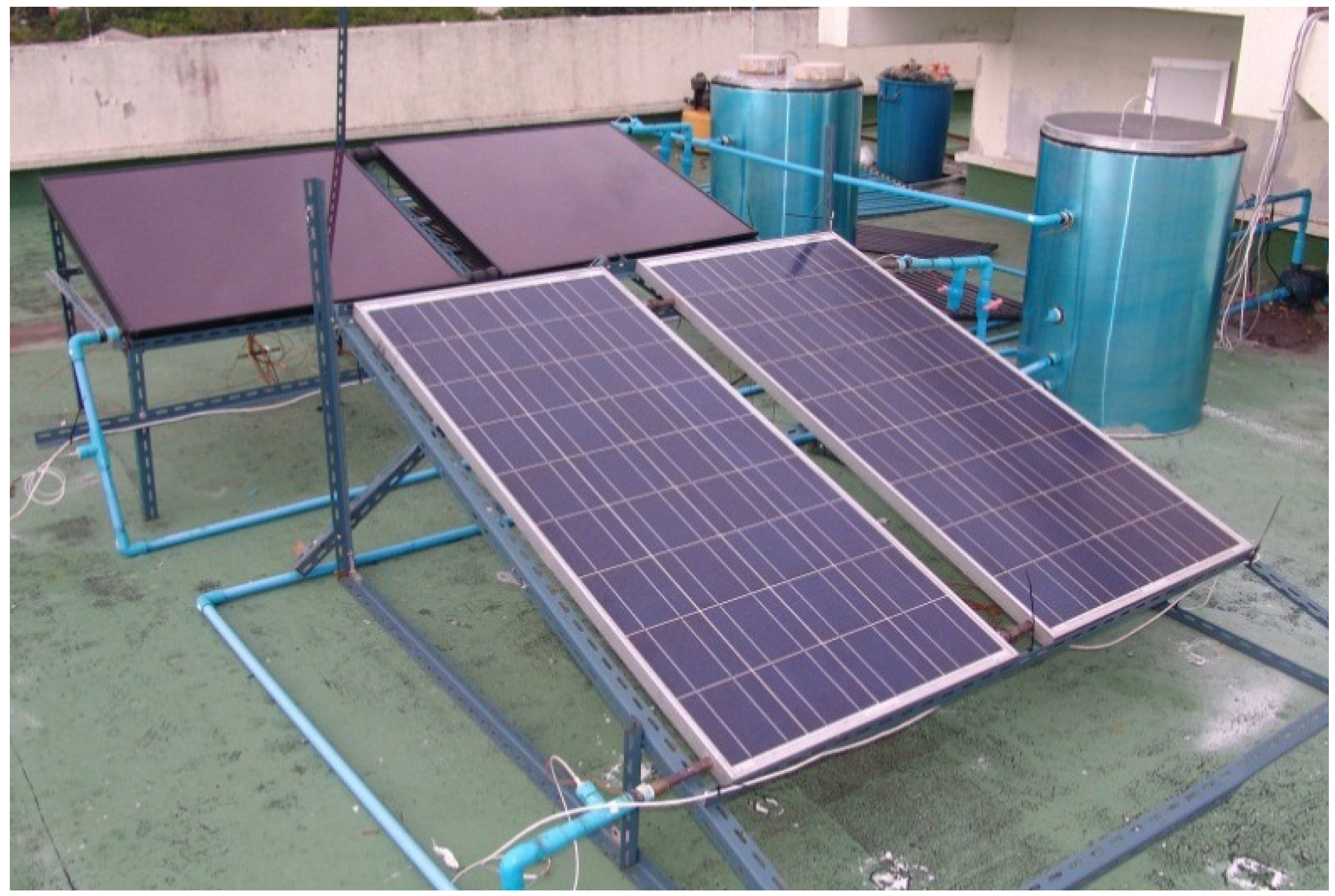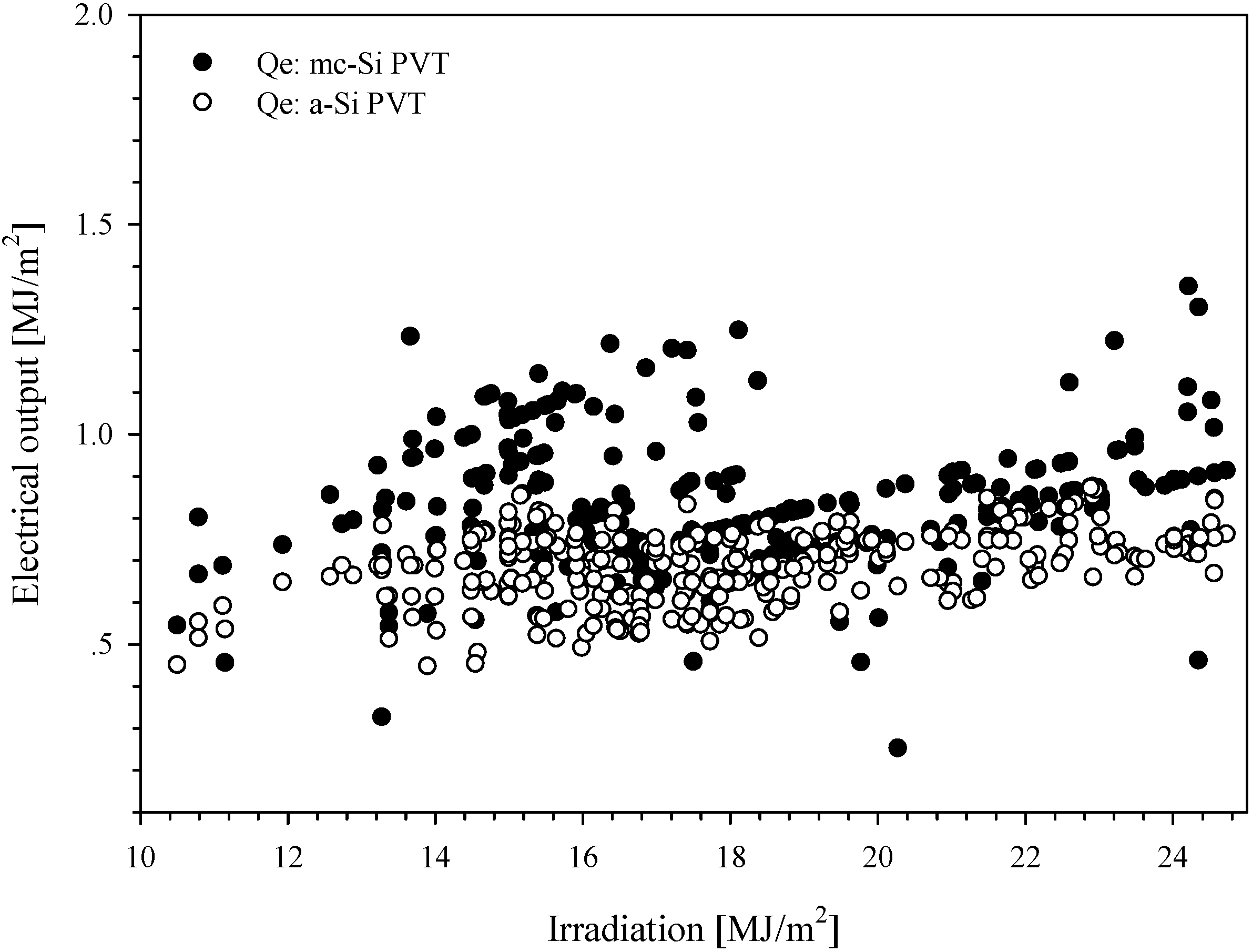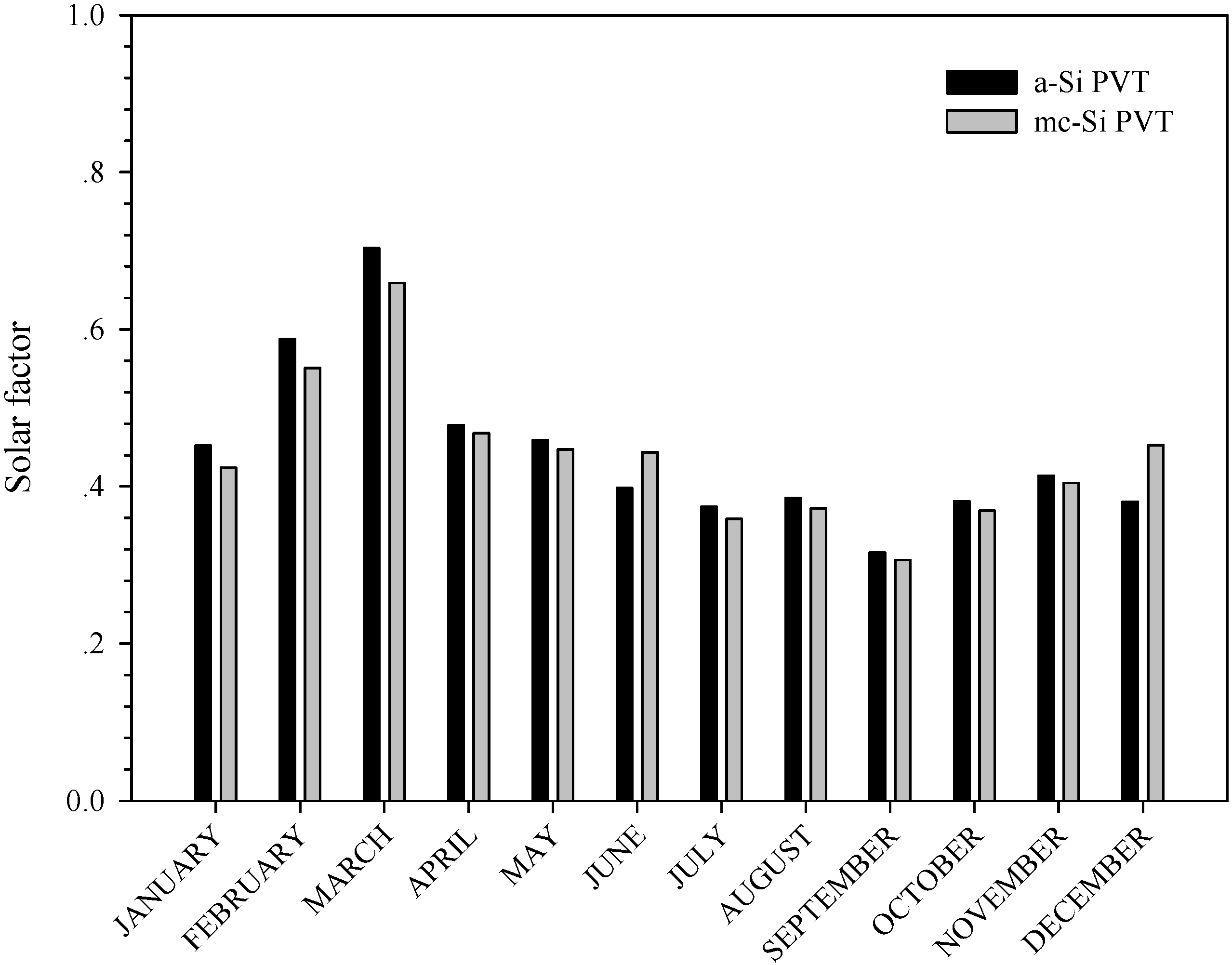Field Experiments of PV-Thermal Collectors for Residential Application in Bangkok
Abstract
:1. Introduction
1.1. Background
1.2. Literature Survey
- Higher energy yield per square meter of surface area.
- Simultaneous production of both electricity and heat by one device.
- Reduced manufacturing and installation cost.
1.3. Objective
2. The Experimental System
2.1. PVT Collector


2.2. Experimental Setup

| Item | a-Si PVT | mc-Si PVT |
|---|---|---|
| Collector area (m2) | 0.9 | 1.96 |
| Packing factor of PVT collector | 0.9 | 0.9 |
| Working fluid thermal capacitance (kJ/kg·K) | 4.19 | 4.19 |
| Nominal efficiency of PV panel (%) | 6.3 | 12.7 |
| Collectors slope (degree) | 15 | 15 |
| Number of glass covers | 1 | 1 |
| Glass cover transmittance | 0.92 | 0.92 |
| Storage tank volume (m3) | 0.12 | 0.12 |
| Temperature coefficient of PV cell efficiency | −0.0023 | −0.0043 |
| Loss coefficient of bottom and edge losses (J/s·m2·K) | 0.31 | 0.31 |

2.3. Environment Conditions



3. Experimental Results
3.1. Daily Energy Production of PVT Systems


3.2. Monthly and Annually Energy Production of PVT Systems


| a-Si PVT | mc-Si PVT | |
|---|---|---|
| Thermal energy output [kWh/m2] | 1.2 × 103 | 1.1 × 103 |
| Electrical energy output [kWh/m2] | 61 | 72 |
| a-Si PVT | mc-Si PVT | |
|---|---|---|
| Payback [years] | 7.6 | 14.5 |
| Capital cost [THB] | 46,400 | 87,500 |
| Maintenance cost [THB/year] | 2000 | 2000 |
| Annual cost saving [THB/year] | 8219 | 8276 |
| Net saving [THB/year] | 6219 | 6276 |
3.3. Thermal and Electrical Efficiency


| a-Si PVT | mc-Si PVT | |
|---|---|---|
| Cell efficiency [%] | 4.0 | 4.6 |
| Thermal efficiency [%] | 51 | 49 |
3.3. Economic Analysis
- Net savings cost is equal to total savings subtracted by yearly maintenance costs (use 2000 THB/year for this study);
- Electricity price provided by The Energy Policy and Planning Office (EPPO) (April 2011) is 2.98 THB/kWh and the electricity was converted to heat by using an electrical heater with conversion efficiency of 70%;
- The price of PV panels is an actual selling price provided by suppliers in Bangkok in 2010;
- The costs of each system component including labor costs were estimated with approximate prices in April 2011 in Bangkok.
4. Discussion
4.1. PVT Performance versus Solar Irradiation


4.2. Solar Factor

4.3. Comparison between a-Si and mc-Si PVT
5. Conclusions
- The maximum energy outputs of both types of PVT collectors occurred in March under the highest monthly irradiation. PVT systems in Bangkok annually produced 1.1 × 103 kWh/m2 of heat as well as 55–83 kWh/m2 of electricity. Approximately 50% of solar input can be converted into thermal energy while 4–5% turns into electricity.
- Either a-Si or mc-Si PVT recovers almost the same amount of heat. On the other hand, mc-Si PVT supplies 1.2 times as much electricity as a-Si PVT because the former has higher nominal efficiency. It should be noted that relatively high ambient temperatures in Bangkok decreases the performance of electricity generation of mc-Si PV cells.
- Based on the comparison of the energy outputs of PVT systems in this study with other PVT systems working under different locations such as Cyprus in Europe, the thermal output of PVT under Bangkok climate is higher than that in Cyprus with the same unit collector area, In contrast, the electrical output in Bangkok is lower, which is a result of the effect that annual ambient temperatures in Bangkok which are higher than that of Cyprus.
- For the economical aspect, the payback years of PVT is 8 and 15 years for a-Si PVT and mc-Si PVT respectively. The payback years of both systems working in Bangkok are acceptable because the system lifetime is expected 20 years. In addition, the results show that the payback of PVT in Bangkok is longer than that in Cyprus.
Nomenclature
| A | aperture area of PVT collector, m2 |
| C | specific heat, kJ/(kg.K) |
| G | incoming solar radiation, kW/m2 |
| I | current at maximum power point of PV panel, A |
| Q | energy, kJ |
| T | temperature, K |
| V | voltage at maximum power point of PV panel, A |
Greek Symbols
| η | efficiency |
Subscripts
| c | heat |
| e | electrical |
| i | inlet |
| m | maximum |
| o | outlet |
| th | thermal |
References
- Janjai, S. Solar Radiation Map of Thailand Developed Using Satellite Data and Ground-Based Meteorological Data; Technical Report; Department of Alternative Energy Development and Efficiency, Ministry of Energy: Bangkok, Thailand, 1999. [Google Scholar]
- Chow, T.; He, W.; Ji, J. Hybrid photovoltaic-thermosyphon water heating system for residential application. Sol. Energy 2006, 80, 298–306. [Google Scholar] [CrossRef]
- Bakker, M. Outdoor performance of uncovered PV/thermal. In Proceedings of 19th European PV Solar Energy Conference and Exhibition, Paris, France, June 2004.
- Tripanagnostopoulos, Y. Hybrid photovoltaic/thermal solar systems. Sol. Energy 2002, 72, 217–234. [Google Scholar] [CrossRef]
- Hisashi, S. Field experimental and analyses on a hybrid solar collector. Appl. Therm. Eng. 2003, 23, 2083–2105. [Google Scholar]
- Nakajima, A. Spectral Effect of a single-junction amorphous silicon solar cell on outdoor performance. Jpn. J. Appl. Phys. 2004, 43, 2425–2431. [Google Scholar] [CrossRef]
- Zondag, A. The yield of different combined PV-thermal collector designs. Sol. Energy 2003, 74, 253–269. [Google Scholar] [CrossRef]
- Florschuetz, L. Extension of the Hottel–Whillier model to the analysis of combined photovoltaic/thermal flat plate collector. Sol. Energy 1979, 22, 361–366. [Google Scholar] [CrossRef]
- Soteris, A.K. Use of TRNSYS for modeling and Simulation of a hybrid PV-thermal solar system for Cyprus. Renew. Energy 2001, 23, 247–260. [Google Scholar]
- Maurice, J. System studies on combined PV/thermal PANELS. In Proceedings of 9th International Conference on Solar Energy in High Latitudes, Leiden, The Netherlands, May, 2001.
- Vokas, G.; Christandonis, N.; Skittids, F. Hybrid photovoltaic-thermal systems for domestic heating and cooling—a theoretical approach. Sol. Energy 2006, 80, 607–615. [Google Scholar] [CrossRef]
- Beccali, M.; Finocchiaro, P.; Nocke, B. Energy and economic assessment of desiccant cooling systems coupled with single glazed air and hybrid PV/thermal solar collectors for applications in hot and humid climate. Sol. Energy 2009, 83, 1828–1846. [Google Scholar] [CrossRef]
- Sukamongkol, Y.; Chungpaibulpatana, S.; Limmeechokchai, B.; Sripadungtham, P. Condenser heat recovery with a PV/T air heating collector to regenerate desiccant for reducing energy use of an air conditioning room. Energy Build. 2010, 42, 315–325. [Google Scholar] [CrossRef]
- Adsten, M.; Perers, B.; Wackelgard, E. The influence of climate and location on collector performance. Renew. Energy 2002, 25, 499–509. [Google Scholar] [CrossRef]
- Manual of TRNSYS (version 16); Solar Energy Laboratory, University of Wisconsin-Madison: Madison, WI, USA, 2005.
- Van Helden, W.G.J.; van Zolingen, R.J.Ch.; Zondag, H.A. PV thermal systems: PV panels supplying renewable electricity and heat. Prog. Photovolt. Res. Appl. 2004, 12, 415–426. [Google Scholar] [CrossRef]
- Tripanagnostopoulos, Y.; Souliotis, M.; Battisti, R.; Corrado, A. Energy cost and LCA results of PV and hybrid PV/T solar systems. Prog. Photovolt. Res. Appl. 2005, 13, 235–250. [Google Scholar] [CrossRef]
© 2012 by the authors; licensee MDPI, Basel, Switzerland. This article is an open access article distributed under the terms and conditions of the Creative Commons Attribution license (http://creativecommons.org/licenses/by/3.0/).
Share and Cite
Nualboonrueng, T.; Tuenpusa, P.; Ueda, Y.; Akisawa, A. Field Experiments of PV-Thermal Collectors for Residential Application in Bangkok. Energies 2012, 5, 1229-1244. https://doi.org/10.3390/en5041229
Nualboonrueng T, Tuenpusa P, Ueda Y, Akisawa A. Field Experiments of PV-Thermal Collectors for Residential Application in Bangkok. Energies. 2012; 5(4):1229-1244. https://doi.org/10.3390/en5041229
Chicago/Turabian StyleNualboonrueng, Thipjak, Pongpith Tuenpusa, Yuki Ueda, and Atsushi Akisawa. 2012. "Field Experiments of PV-Thermal Collectors for Residential Application in Bangkok" Energies 5, no. 4: 1229-1244. https://doi.org/10.3390/en5041229
APA StyleNualboonrueng, T., Tuenpusa, P., Ueda, Y., & Akisawa, A. (2012). Field Experiments of PV-Thermal Collectors for Residential Application in Bangkok. Energies, 5(4), 1229-1244. https://doi.org/10.3390/en5041229




